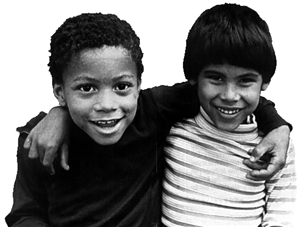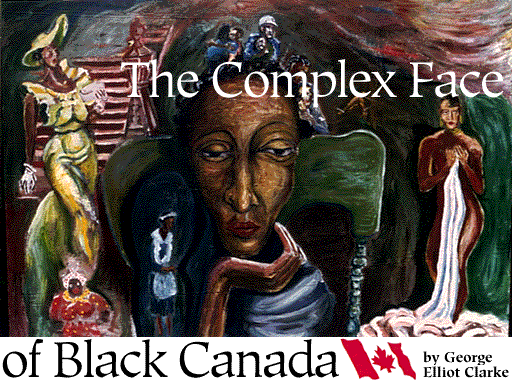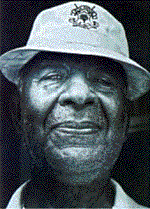 |
 | ||||
 | |||||
 | |||||
 | |||||
A few summers ago, via rail offered an enticing 50 percent fare reduction for foreign visitors to Canada, but did not advertise the bargain, suspecting that it would anger Canadians whose taxes subsidize the corporation. I learned about the scheme while purchasing a ticket in Kingston, Ontario. The agent asked, stealthily, for my passport. I was puzzled. "What do you mean, my passport?" She then advised me about the discount for foreigners, specifying that my "American accent" marked me as an eligible passenger. I informed the agent that (as the très white beer commercial says), "I AM CANADIAN." But it's never been simple to be a black in Canada. My bloodlines run deep in this country. My father's father was West Indian - but his mother's father came to Nova Scotia from Virginia in 1898. My mother's ancestors - slaves liberated by British forces during the War of 1812 - voyaged to Nova Scotia, from Chesapeake Bay, in 1813. I was born, raised, and educated in Nova Scotia. I went to Expo '67, I sang along with Ian and Sylvia and the Great Speckled Bird, I wanted Robert Stanfield to win in '72. Either I am Canadian, or the word means nothing. Then again, the VIA Rail incident was not about accent. Because my skin distinguishes me from most Canadians, most assume that I hail from "somewhere else." When someone asks what island I'm from, I reply: "Cape Breton." Moreover, Canadians are abysmally ignorant about African-Canadian history. For instance, a Canadian Civil Liberties Association poll, conducted in 1995, found that 83 percent of Canadians did not know that slavery had been practiced in pre-Confederation Canada.
A McGill study published this year provides the most current demographic information about Canada's black community and provides some surprising insights. Although I prefer the terms African-Canadian or Africadian - it captures the experiences of those from the United States, Africa, and Caribbean - the authors sought to understand the "black experience" and how blacks fare in Canadian society. Diversity, Mobility & Change: The Dynamics of Black Communities in Canada was written by McGill Professor of Social Work James Torczyner along with colleagues Wally Boxhill, Crystal Mulder and Carl James. The report is a response to one consequence of African-Canadian diversity: the fact that almost half of us do not identify ourselves as "black" on Canadian census documents. Indeed, 43 percent of African-heritage respondents to the 1991 census listed themselves as French or British, or as Barbadian, Ethiopian, Ghanaian, Haitian, Somali, Jamaican, Trinidadian / Tobagonian, etc., leading to a serious undercounting of African-heritage Canadians. Wally Boxhill, a former Statistics Canada employee, re-cast the numbers to include the above groups as Black Canadians. This means that, as of 1991, there were 504, 290 blacks in Canada, not 366,625 as formerly counted. These figures bear consequences, but before I discuss them, I want to tease out an issue that seems to have eluded the study's compilers, namely, the reason for the failure of so many African-Canadians to call themselves "black." As Boxhill tells us in a fine essay, "about half the respondents born in Haiti who were, in all likelihood, black reported that they were French. A similarly high proportion of persons born in Jamaica reported that they were British." These self-identifications are neither surprising nor disturbing, if we understand that anti-Africanism, the social construct that turns human beings into "black" and "white" (in the U.S. and Canada), is not a potent source for identity in Haiti or Jamaica, the two countries which have contributed the greatest numbers of African-heritage immigrants to Canada in the past 30 years. (Torczyner tells us that 44.2 percent of all black persons in Canada immigrated in the past 20 years.) As Quebec writer Dany Laferrière's 1985 satire, Comment faire l'amour avec un Nègre sans se fatiguer (How to Make Love to a Negro Without Getting Tired), takes uproarious pains to point out, it is only on the North American mainland that a Haitian becomes "black," or is expected to subscribe, instantly, to the white-black angst that plagues the white (and white supremacist) majority in the U.S. and Canada. In black-majority countries, social divisions occur around class and less so around race (though "colourism," that is, discrimination by light-skinned blacks against darker-skinned blacks, is a problem). In 1973, the Barbados-born African-Canadian writer Austin Clarke described the "West Indian writer" as "a man from a society os-tensibly free of the worst pathologies of racialism, a man from a society into which black nationalism had to be imported from American Blacks." Clarke's comment underlines the weirdness of white-vs.-black constructs for many Caribbean emigrés. (I will never forget the chaos that ensued when Haiti-born Jean Alfred, a péquiste MNA, told a meeting of the now-defunct National Black Coalition of Canada, in Toronto, in May 1979, that he cared more about the liberation of Quebec than he did about "national black unity." The black community felt its needs should be paramount.)
Too, once black immigrants have been settled for a long enough period in Canada, they also begin to confront the barriers that white supremacism erects against black achievement in this society, barriers that indigenous African-Canadians understand intimately. A Trinidad-born, black scholar-friend of mind told me that in celebrating a recent success of his with several white Canadian colleagues, one of them said, after a few drinks, "Well, David, you may have won a grant, but I'm still a white man." How does the fact that so many blacks identify themselves with where they came from, and not their colour, affect Canada? I foresee a rapprochement in which immigrant African-Canadians who identify with their homeland establish an affinity with Canadian-born blacks and exchange strategies of resistance to racism, the common denominator of the black experience. These strategies include both arguing loudly against injustices and attempting some organizing to reduce the incidence of poverty and illiteracy. The Canadian black community, accounting for only two percent of the Canadian population, will have a more difficult time achieving the strength of solidarity than African-Americans, who comprise 13 percent of the American population. In Canada, the growing numbers of second-generation blacks have more in common with the experiences of indigenous African-Canadians than with an increasingly remote Caribbean "homeland." Two writers who wonderfully evoke this sensibility are Montrealer Robert Edison Sandiford, the son of Bajan immigrants, in his short story collection Winter, Spring, Summer, Fall, and Stories and Calgary's Suzette Mayr, the daughter of German and Caribbean immigrants, in her novel Moon Honey in which the protagonist changes from white to brown. Canada's blacks are primarily an urban people living in Montreal and Toronto. Boxhill reports that some 240,940 blacks live in Toronto, representing 47.8 percent of the African-Canadian population; another 101,890 blacks live in Montreal, accounting for another 20.1 percent of the total. Although African-Canadians are largely urban people, rural enclaves still exist in Nova Scotia, New Brunswick, south-western Ontario, and in Alberta and Saskatchewan. Halifax and Vancouver (with its 3.1 percent of the African-Canadian population, that is, 15, 385 souls) are crucial centres in their own right. Undeniably, the concentration of blacks in Canada's two largest cities grants these populations some political and economic clout. Not unexpectedly, then, Ontario has sent blacks, beginning with Lincoln Alexander, to the House of Commons in every election since 1968; in contrast, the first Black Nova Scotian (or Africadian, to use my preferred term) to enter Parliament, Gordon Earle, was elected only this past spring in Halifax, a city containing just 2.1 percent of the African-Canadian population (that is, 10,560 souls). Though it was possible to elect a black, Leonard Braithwaite, to the Ontario legislature in 1963, the feat could not be accomplished in the Nova Scotia legislature until 1993, when Wayne Adams won the special riding of Preston (the largest all-black community in Canada). As well as illustrating diversity, Torczyner's review of the census data tells us much about mobility and adds to our knowledge of the social circumstances of African- Canadians. His statistics offer a picture of relative black success, despite the community's well-founded complaints of job, school and housing discrimination as well as its justified charges of police brutality against black males. However, black men fare better educationally and economically in Canada than they do in the United States. Torczyner finds that "Black men have marginally higher levels of educational attainment than do all men, all women, or black women in Canada." The explanation for this fact is, I wager, the premium that Caribbean and African governments place upon education, especially technical and scientific instruction, particularly for males. In searching the National Library of Canada for literary books by black authors, one discovers often, instead, droves of dissertations, mainly in the sciences, by African-born doctoral candidates. The point is well illustrated by St. Vincent-born author H. Nigel Thomas in Spirits in the Dark, in which the male protagonist is groomed for scholastic achievement by male elders in his society. Some 3.1 percent of African-Canadian men have master's degrees - more than the Canadian population as a whole. Another explanation lies in Canadian immigration policy, which at first admitted only Carib-bean women as dome-stics, and later admitted black men, but with a bias for professionals. (Torczyner's discovery that there are 20,000 more black women than men in Canada is attributable to federal immigration rules. This also explains, in part, the higher number of female-led, single-parent households among African-Canadians than among Canadians as a whole.) Furthermore, some Africans who entered Canada as students chose to remain here after they had completed their education. Too, many of the Haitians who fled the Duvalier dictatorships in the 1960s and 1970s represented their nation's intelligentsia. When Torczyner states that "Black persons in Montreal had the highest rates of educational attainment when compared to Toronto and Halifax," he may be referring to that fact. Moreover, the Africans who fled apartheid in South Africa, civil wars in Somalia and Ethiopia, and dictatorships in Uganda, Nigeria and elsewhere tended to be well-educated members of their nations. Canada has simply benefited - quite deliberately - from an epochal brain drain. Hence, in Canada one in five African-Canadians is enrolled in university or has a bachelor's degree - which, at 20 percent, is on par with the Canadian population as a whole.
Blacks are less likely to be self-employed or supported by investments. Finally, there is the depressing summation that "Black persons in Canada earn less money on average than the Canadian population as a whole" ($20,617 per year or 15 percent less than the Canadian average, $24,001.) Further, despite the positive educational and employment indicators, and despite the fact that "members of the black community are less likely to be dependent on public assistance through transfer payments for their support" than is the population as a whole (10.6 percent compared to 11.4 percent), almost a third of all African-Canadians, some 31.5 percent of the population, lived below the Canadian poverty line in 1991, including 40 percent of all African-Canadian children. These rates are appalling. They cry out for remedial action from all levels of government and religious institutions, but also from the African-Canadian communities themselves. Torczyner's call, in his conclusion, for "community organizing strategies to promote access to entitlements," to ensure that eligible families receive mandated public supports, is one place to start. Also valuable is Torczyner's suggestion that African-Canadi-ans need to develop a "national black consensus." This is easier said than done in a country that has difficulty finding a consensus on anything. Nevertheless, his promotion of "a parliament of Black communities in Canada" is intriguing, to say the least. Diversity, Mobility & Change begins to answer, for Canada, a challenge that Du Bois issued to American sociologists in 1898 to study the "Negro problems." His rhetoric (the language of the day) is problematic, but his insight is valid. We can only truly weld to-gether an African-Canadian people by studying intensively our conditions, from coast to coast to coast, across five-and-one-half time zones, two official languages, and a hundred ethnicities. Torczyner, Boxhill, James, and Mulder have made a remarkable stride in that direction. That's not to say the report is perfect. I wish, for instance, that the brief survey of African-Canadian history had referenced a few more texts, including Robin W. Winks's The Blacks in Canada: A History (1971), despite its American liberal blindness toward the substantive Canadian difference from the U.S., and James Walker's The West Indians in Canada (1984). I also wish that greater precision had been granted figures and dates in the historical essay. (For example, 1,500 not 2,500, Black Loyalists left Nova Scotia for Sierra Leone in 1792.) Discussing Black Canadian economic statistics, Torczyner could have referred to Adrienne Shadd's 1987 study of black male employment and wage rates in Ontario and Nova Scotia as well as to Agnes Calliste's 1995 essay on black families in Canada. Peccadilloes and omissions aside, the McGill group merits kudos for taking a relatively wide-angle snapshot of the state of African Canada. George Elliott Clarke is a professor of English and Canadian Studies at Duke University in Durham, North Carolina. Report Reference: Diversity, Mobility and Change: The Dynamics of Black Communities in Canada. McGill Consortium for Ethnicity and Strategic Social Planning, 1997, $20. Contact: (514) 398-6696.
 | |||||

 To be black in Canada, then, is an existential experience. A constant interrogation of our belonging is inculcated within us. It is not just the "double consciousness" that the great African-American intellectual W.E.B. Du Bois (pronounced "Do Boyce" in the U.S.) posited for Black Americans, but a "poly-consciousness." For as our blackness ranges from ivory to indigo hues, our heritages, ethnic allegiances, religions, and languages are also varied. In fact, African Canada, in its gorgeous, explicit diversity, is a microcosm of Canada.
To be black in Canada, then, is an existential experience. A constant interrogation of our belonging is inculcated within us. It is not just the "double consciousness" that the great African-American intellectual W.E.B. Du Bois (pronounced "Do Boyce" in the U.S.) posited for Black Americans, but a "poly-consciousness." For as our blackness ranges from ivory to indigo hues, our heritages, ethnic allegiances, religions, and languages are also varied. In fact, African Canada, in its gorgeous, explicit diversity, is a microcosm of Canada.
 What all this means is that Canadian blackness is a complex identity, rich with contradictions and fissures. Certainly the danger in talking about "Canadian Blacks" is that one can elide the real differences among, say, a Vancouver Rastafarian, an Anjou Sénégalaise, and a "Scotian" African Baptist. The Torczyner study skirts this problem, but only barely. Torczyner recognizes, in his informative text, that there are "unique regional agendas for the various Canadian black communities." Still, he tends to take the immigrant black experience, especially in Ontario and Quebec (where 38.5% of all "Blacks" live), as the norm, even arguing that "black immigration" will "determine something of the collective identity of black persons in Canada." Yet the centuries-old African-heritage populations in the Mari-times, Quebec and south-western Ontario are jealously insisting upon recovering and rejoicing in their histories. Torczyner does state that "in Halifax, with its long history of Black settlement, more than nine out of ten persons in the black communities were born in Canada, and the 'Caribbean influence' is comparatively low." But this knowledge does not pervade the study.
What all this means is that Canadian blackness is a complex identity, rich with contradictions and fissures. Certainly the danger in talking about "Canadian Blacks" is that one can elide the real differences among, say, a Vancouver Rastafarian, an Anjou Sénégalaise, and a "Scotian" African Baptist. The Torczyner study skirts this problem, but only barely. Torczyner recognizes, in his informative text, that there are "unique regional agendas for the various Canadian black communities." Still, he tends to take the immigrant black experience, especially in Ontario and Quebec (where 38.5% of all "Blacks" live), as the norm, even arguing that "black immigration" will "determine something of the collective identity of black persons in Canada." Yet the centuries-old African-heritage populations in the Mari-times, Quebec and south-western Ontario are jealously insisting upon recovering and rejoicing in their histories. Torczyner does state that "in Halifax, with its long history of Black settlement, more than nine out of ten persons in the black communities were born in Canada, and the 'Caribbean influence' is comparatively low." But this knowledge does not pervade the study.
